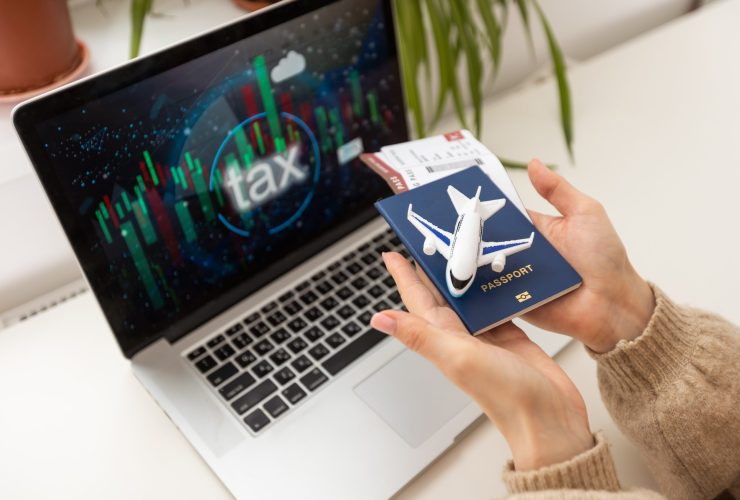Navigating Lyft & Uber Driver Taxes
Navigating “Uber driver taxes” can be a complex task for those involved in the ride-sharing services of Uber and Lyft.
The traditional 9-to-5 job remains prevalent, but an increasing number of people are engaging in the “sharing economy.” This trend is fueled by social media and the ability to offer or rent goods and services through online platforms.
You might be familiar with these services. Uber and Lyft are leading examples of the sharing economy, enabling regular individuals to use app-based platforms to provide transportation services.
Recognizing the rise of the sharing economy, the United States Internal Revenue Service (IRS) has launched a new Sharing Economy Resource Center. This center is aimed at helping taxpayers navigate tax filing for income earned from driving for Uber or Lyft.
The introduction of the IRS’ online resource center highlights the U.S. Federal Government’s awareness of the sharing economy’s growth and its interest in ensuring tax compliance for income generated through these modern service models.
According to IRS Commissioner John Koskinen, “This rapidly evolving area often presents new challenges for people engaged in these economic activities, whether they are renting a room or providing a ride. The IRS is working to help people in this area by providing them the information and resources they need to file accurate tax returns.”
Tip 1: Understand Your Tax Status

If you’re an Uber or Lyft driver, it’s crucial to understand your tax status. Unlike traditional employees, ride-share drivers are classified as independent contractors. This classification has significant implications for your taxes.
Independent Contractor: What Does It Mean?
As an independent contractor, you are essentially running your own business. This means you are responsible for tracking your income and managing your taxes. Unlike traditional employees, Uber driver taxes are not automatically withheld from your earnings. This can be both a challenge and an opportunity.
The Self-Employment Tax
One of the key tax obligations you’ll face is the self-employment tax. This tax covers Social Security and Medicare contributions, which are typically split between employees and employers. As an independent contractor, you’re responsible for the entire amount.
Here’s a simple breakdown of what this means for you:
| Component | Rate | Description |
|---|---|---|
| Social Security | 12.4% | Goes towards your future SS benefits |
| Medicare | 2.9% | Covers Medicare contributions |
| Total | 15.3% | Total rate of self-employment tax |
Calculating Your Taxable Income
To figure out your taxable income, you’ll subtract your business expenses from your gross income. This is where tracking every penny you earn and spend becomes vital. The lower your taxable income, the less tax you’ll owe.
Why This Matters
Understanding your tax status as an independent contractor is vital. It affects how much tax you owe, when you pay it, and what deductions you can claim. Without this knowledge, you could face unexpected tax bills or miss out on valuable deductions.
Key Takeaways:
- Ride-share drivers are classified as independent contractors.
- You are responsible for paying self-employment tax, which includes Social Security and Medicare.
- Understanding and managing your tax obligations is crucial to avoid surprises during tax season.
Stay informed and plan ahead to make the most of your ride-share driving experience. Remember, a little knowledge goes a long way in managing your taxes effectively.
Tip 2: Keep Accurate Records

As an Uber or Lyft driver, it’s essential to track and report your income accurately. This is a key aspect of managing your taxes as an independent contractor. Here’s how to handle it effectively.
Importance of Accurate Record Keeping
Your income as a ride-share driver isn’t just what you see in your weekly payouts. It includes everything from the fares you collect to tips and bonuses. Accurate record-keeping ensures you report the correct amount of income to the IRS and helps you identify eligible deductions.
How Uber and Lyft Report Your Earnings
Both Uber and Lyft provide annual summaries that detail your earnings and potential deductions. These documents are critical for your tax preparation. However, they may not cover everything, especially tips and additional income not processed through the app.
Tips for Tracking Additional Income
To keep track of additional income, follow these simple steps:
- Maintain a Dedicated Record:
- Use a spreadsheet or a specialized app to log every amount you earn, including cash tips and bonuses.
- Regularly Update Your Records:
- Update your records at least weekly to ensure accuracy and prevent a backlog.
- Understand Your Earnings Statements:
- Familiarize yourself with the layout and content of your Uber or Lyft earnings statements. They provide a lot of useful information for tax purposes.
- Be Consistent:
- Consistency is key. Make it a habit to record your earnings after every shift or on a set schedule.
Key Takeaways:
- Accurate income tracking is crucial for tax purposes.
- Regularly update and maintain a record of all your earnings, including tips and bonuses.
- Understand and utilize the annual summaries provided by Uber and Lyft.
By staying organized and diligent with your income tracking, you’ll be better prepared for tax season and can ensure you’re reporting your income accurately. Remember, good record-keeping is the foundation of effective tax management for independent contractors.
Tip 3: Understand Deductible Expenses
For Uber and Lyft drivers, understanding what expenses can be deducted from your taxes is key to reducing your taxable income. Here’s a guide to the most common deductible expenses and how to track them effectively.
Common Deductible Expenses for Ride-Share Drivers
As a driver, several expenses directly related to your business can be deducted. These include:
- Car Maintenance and Repairs: Costs for maintaining and repairing your vehicle, such as oil changes, tire rotations, and other necessary services.
- Fuel Costs: The money you spend on gas while driving for Uber or Lyft.
- Insurance: Part of your vehicle insurance can be deducted, as long as it’s related to your ride-share driving.
- Mobile Phone Bills: A portion of your mobile phone bills, since it’s essential for your ride-share business.
- Car Depreciation: This is a bit more complex, but you can deduct the depreciation of your vehicle over time.
Tracking Expenses Effectively
To maximize your deductions, you need to keep meticulous records of your expenses. Here’s how to do it:
- Keep All Receipts:
- Store receipts for gas, maintenance, insurance, and other expenses.
- Use a Dedicated App or Spreadsheet:
- Track your expenses using a specialized app or a simple spreadsheet.
- Categorize Your Expenses:
- Organize your expenses into categories (e.g., fuel, maintenance) for easier management and reporting.
Example of Expense Tracking Table
| Date | Category | Amount ($) | Notes |
|---|---|---|---|
| Jan 1, 2024 | Fuel | 30 | – |
| Jan 5, 2024 | Car Maintenance | 100 | Oil change |
| Jan 10, 2024 | Insurance | 120 | Monthly insurance |
| Jan 15, 2024 | Phone Bill | 60 | Portion for business |
| … | … | … | … |
Key Takeaways:
- Keep track of all business-related expenses to maximize your tax deductions.
- Use an organized system to record and categorize your expenses.
- Remember, accurate expense tracking can significantly lower your taxable income.
By understanding and diligently tracking your deductible expenses, you can effectively reduce your taxable income and thereby lower your tax burden. Good expense management is an essential part of being a successful independent contractor in the ride-share industry.
Tip 4: Pay Quarterly Estimated Taxes
As an Uber or Lyft driver, paying quarterly estimated taxes is a crucial aspect of your financial responsibilities. This section will guide you through understanding and managing these taxes.
What are Quarterly Estimated Taxes?
Quarterly estimated taxes are payments made to the IRS four times a year. They cover your income tax and self-employment tax obligations. Since taxes aren’t withheld from your earnings as an independent contractor, these payments prevent you from owing a large sum at the end of the year.
Who Should Pay Them?
If you expect to owe at least $1,000 in taxes after subtracting your withholding and credits, you should be making estimated tax payments. This is a common scenario for full-time Uber and Lyft drivers.
How to Calculate Estimated Taxes
To calculate your estimated taxes, follow these steps:
- Estimate Your Annual Taxable Income:
- Add up your expected earnings and subtract your deductions to find your taxable income.
- Calculate Your Tax Liability:
- Use the IRS tax rates to estimate your income tax and add 15.3% for self-employment tax.
- Divide by Four:
- Divide your estimated tax liability by four to find your quarterly payment.
Deadlines for Payment
The IRS has set deadlines for each payment:
- 1st Payment: April 15
- 2nd Payment: June 15
- 3rd Payment: September 15
- 4th Payment: January 15 (of the following year)
Key Takeaways:
- Quarterly estimated taxes are crucial for managing your tax obligations.
- Determine if you need to make these payments based on your estimated tax liability.
- Accurately calculate and make timely payments to avoid penalties.
Managing your quarterly estimated taxes effectively ensures that you stay compliant with IRS requirements and avoid any unexpected tax bills at the end of the year. As always, if you’re uncertain about how to handle these payments, consulting a tax professional is advisable.
Tip 5: Seek Professional Help
Navigating Uber driver taxes can often be intricate. In such cases, seeking professional help can be the most effective approach. Here’s a concise guide on when and why it’s advisable to consult a tax professional for Uber driver taxes.
When to Consult a Tax Professional
- Complex Tax Situations: If you have multiple income streams or complex deductions, a tax professional can provide clarity and expertise.
- First-time Filing: If you’re new to filing taxes as an independent contractor, getting professional guidance can ensure you start on the right foot.
- Major Changes in Your Driving Business: Significant changes, like a dramatic increase in income or purchasing a new vehicle for your business, might affect your tax situation.
Benefits of Professional Tax Help
- Expert Advice: Tax professionals are up-to-date with tax laws and can offer tailored advice.
- Maximize Deductions: They can help identify all the deductions you’re entitled to, potentially saving you money.
- Peace of Mind: Knowing an expert is handling your taxes can reduce stress and uncertainty.
Finding the Right Professional
Look for a tax professional with experience in gig economy taxes. This ensures they understand the unique aspects of your work as a ride-share driver.
Key Takeaways:
- Consider professional tax help for complex situations or when you’re new to ride-share driving.
- A tax professional can help maximize your deductions and provide peace of mind.
- Choose someone experienced with gig economy taxes for the best advice.
Seeking professional help can be a valuable investment, ensuring you stay compliant and optimize your tax situation as an Uber or Lyft driver.




